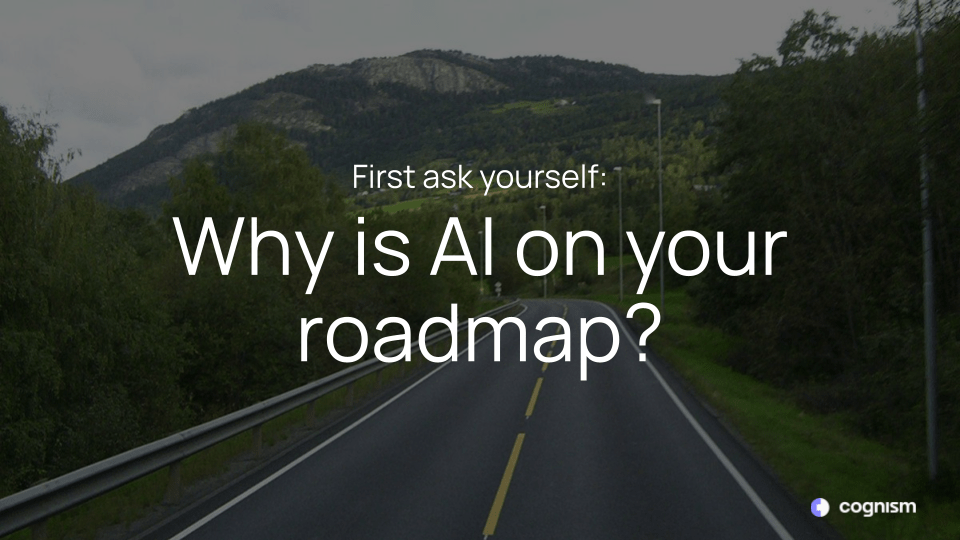Why AI spending needs a strategy now
AI promises faster product development, higher efficiency, and smarter customer experiences. But in many SaaS companies, AI investments risk becoming expensive distractions unless they are clearly tied to business outcomes.
That was the warning from Adam Thompson, Chief Product Officer at Cognism, during his keynote at SaaSiest 2025. With deep product leadership experience, a PhD in knowledge management, and a track record of launching successful AI-powered tools, Adam offered a practical framework for justifying AI investments with measurable impact.
This article breaks down his six-step playbook for defending AI spending and product development costs—based on real-life results from Cognism.

The 6-step AI investment strategy for SaaS leaders
Step 1: Identify the business metrics that matter
Adam’s first rule: never start with the tech. Start with the business goal.
Whether your aim is to improve retention, increase average contract value, expand total addressable market (TAM), or reduce churn, you need to be laser-focused on one or two metrics.
Examples of key SaaS metrics to target:
- Growth: TAM expansion, ACV uplift
- Retention: Gross Revenue Retention (GRR), Net Revenue Retention (NRR)
- Efficiency: Margin improvement, sales win rates, product development velocity
“If you can’t say what problem you’re solving or what metric you’re moving, you’re not ready to build,” Adam said.
Step 2: Align on quantitative and qualitative targets
Once your primary metric is defined, align with internal stakeholders on realistic targets.
Use a mix of data sources:
- Quantitative: sales projections, cost-of-delay estimates, NPS trends, operational benchmarks
- Qualitative: Gong call insights, G2 reviews, competitive intel, customer feedback
In Cognism’s case, the product team set a goal to:
- Raise GRR from 59% to 70% (with a path toward 80%)
- Improve sales win rate by 10%
- Migrate $6 million of credit-based revenue within six months
This made the investment feel specific, trackable, and relevant across departments.
Step 3: Model the cost (and plan for scale)
Finance will want the numbers. Come prepared.
At Cognism, the team budgeted:
- $1.25 million annually for the product squad and infrastructure
- 20% cost of goods sold (COGS) for scalability
Adam also flagged a common mistake in AI-driven tools: underestimating usage costs. If users love it, your infrastructure costs could spike. Plan for usage that is three to four times higher than projected.
SEO Tip: This step speaks directly to “how to calculate ROI on AI product development.”
Step 4: Identify internal champions
Big bets need strong internal support. Find your champions and align their goals with your proposal.
Key decision makers to engage:
- CFO: cares about efficiency, valuation multiples, and capital allocation
- CRO: wants to improve pipeline velocity, win rates, and deal value
- CMO: values differentiation and customer insights
- CEO and Board: useful for air cover, but handle with care
Adam recommends treating these internal allies like buyer personas. What do they care about? How can you frame your project in their language?
Step 5: Build a business case through storytelling
Hard data earns trust. A clear narrative earns buy-in.
Cognism had a real challenge: their credit-based revenue had a GRR of just 59%, compared to 91% for their license-based products. Worse, they discovered that 50% of usage came from marketers—despite being a sales-focused tool.
This insight led to the creation of a new product line, Cognism Audiences, aimed directly at marketing teams, moving away from complex credit systems to a records-under-management model.
By clearly connecting customer pain, revenue loss, and product opportunity, Adam’s team made the investment story compelling for both finance and sales leadership.
Step 6: Prove impact with leading indicators
Retention improvements take time. But you can’t wait a year to show results.
Instead, track leading indicators:
- Activation and usage metrics
- Demo conversion rates
- Analyst coverage
- Early customer NPS or CSAT scores
- Engineering velocity linked to business outcomes
“Find something you can report on in 30 to 60 days,” Adam advised. “Don’t wait a year to prove this was worth it.”
The Cognism case study: $1.2M in annual retention risk reframed
By applying this six-step AI investment playbook, Adam’s team uncovered that $1.2 million in annual revenue was at risk due to poor retention in their credit-based pricing model.
By repositioning the product for marketers and launching a new offering with SaaS-style usage, they’re now on track to reverse that trend—with strong CFO and CRO alignment, clear targets, and predictable cost modeling.
Key takeaway for SaaS leaders
AI is not a strategy. It is a tool. And unless it maps back to the core metrics that drive your business, it could be a costly distraction.
Follow this six-step playbook to turn hype into outcomes:
- Define your primary business metric
- Set credible targets
- Model cost and usage
- Build internal champions
- Tell the right story
- Measure impact early and often
Done well, AI investments can boost retention, win rates, and company valuation.
Done poorly, they waste precious time and resources.
Watch Adam’s full session from SaaSiest 2025 here